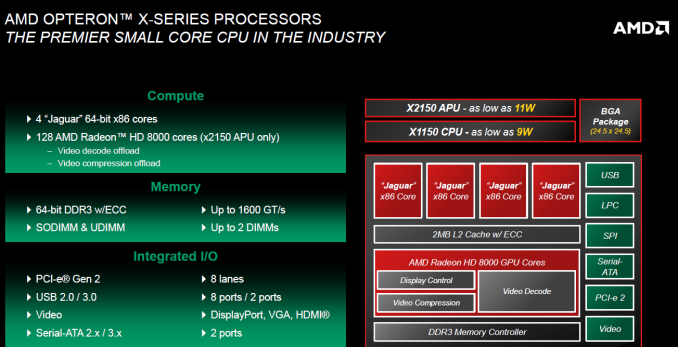AMD Evolving Fast to Survive in the Server Market Jungle
by Johan De Gelas on June 18, 2013 6:00 AM EST- Posted in
- AMD
- CPUs
- Arm
- Enterprise
Time for New Server CPUs!
While the network fabric and optimized motherboard designs were the key features of the micro server, it is clear that there is room for a “specialized micro server CPU” between the current anemic Atoms and the low power Xeons and Opterons. AMD announced last week the quadcore Opteron-X series, based upon the Jaguar core. The quadcore X1150 is claimed to perform twice as fast as the current Atoms at 2 GHz, but needs 17W to achieve this. You can lower the power usage by fiddling with a p-state cap in the BIOS. Unfortunately the 9W number that so many publications talked about without further commentary is only achieved at 1 GHz. At that clockspeed the performance per Watt advantage will be negligible compared to the 2 GHz Atom S1260 at 8.5W. The best performance/watt will be achieved somewhere between 1.5 and 2 GHz, but the advantage that the new Opteron-X has over the Atom is not as large as many people thought. Unless of course you can make use of the floating point processing power of the integrated Radeon core in the Opteron X-1250 APU.
But although the new Opteron-X can not offer a massive performance/watt improvement over the Atom, it is a much more attractive micro server chip. It can deliver the “good enough” horsepower that an Atom can not deliver. But then again, the current low power Ivy Bridge based Xeon, the Xeon E3-1220LV2 was already a very good micro server chip. But those who think that AMD will be contend with an underdog role once again, are wrong. AMD has a pretty ambitious roadmap to attack this market.











80 Comments
View All Comments
Wilco1 - Tuesday, June 18, 2013 - link
Didn't you read the news that Intel appears to be delaying 14nm introduction to 2015? And where did you see that Avoton has 20 cores? At best they might have 8.Nobody has compared A57 and Avoton branch predictors yet, so the jury is out on that. Same for power efficiency.
1008anan - Tuesday, June 18, 2013 - link
A friend Ashraf wrote an article about the 14 nm "delay" not being that big of a delay:http://seekingalpha.com/article/1503982-intel-s-14...
Avoton SoC packages might include 20 cores. More than one die per package.
JDG1980 - Tuesday, June 18, 2013 - link
I know I love to get my tech news from *investment* websites. (/sarcasm)Wilco1 - Tuesday, June 18, 2013 - link
A delay is a delay. And a link to a tech site which mentions that 20 core Avoton?iwod - Wednesday, June 19, 2013 - link
14nm is only being delayed on Desktop where there are NO competition. It is on schedule for Atom and Mobile CPU.LordanSS - Tuesday, June 18, 2013 - link
I believe the road AMD has chosen has a good future for them... the only problem is that, currently, that road is very rocky and difficult to drive through.Once they manage to fulfill their "Fusion" plans, we won't need to be bothered by the anemic FPU units paired on each Piledriver/Steamroller/whatever module, mostly because that computing should be done on the GPU (which, by the time the Fusion is complete, would be an integral part of the processor itself).
Unfortunately we're still a few years away from such... and I hope they (greatly) improve integer performance on their cores until then. But I do believe it's going to happen, and it'll be great.
Think of the old "math co-processors" of the past, back in the 386 days (they got integrated on the 486 models). The only difference now tho, is that a GCN IGP unit of today has an order of magnitude more compute/FPU power than Intel parts. If you fast forward to the future, and get that improved even more and fused into the CPU....
RandSec - Tuesday, June 18, 2013 - link
"AMD can't expect third-party code to be rewritten to accomodate their processors." AMD doesn't have the market share to tell software vendors to do things their way."Not true. AMD has *more* than mere market share, it has *complete* *market* *dominance* in the new gaming consoles. *All* of gaming graphics software expertise is now focused on leveraging CPU / GPU tradeoffs in the AMD APU design. If advantages really exist, they will be found and exposed, and new software will go that way as well, if only for AMD users. For example, it would seem that the GPU has plenty of fast FP, which need not also be in the CPU, *provided* it can be accessed easily without copying back and forth.
ruiner5000 - Tuesday, June 18, 2013 - link
What is this second great depression we are talking about? I think that is a myth. I don't see any dust bowls or soup lines. Certainly not here in Austin, where AMD is. What you had to wait an extra week to pick up your iPhone 5 and were depressed, and that's the 2nd great depression? Have you ever talked to anyone who was actually alive during the great depression? Wimps.SunLord - Tuesday, June 18, 2013 - link
We're not going to see any major x86 architecture changes from AMD till at least 2015 if not 2016 thats about how long it takes to design and deploy a newly designed architecture which is hopefully what the major rehires from last year will be working on. So we're stuck with mostly minor tweaks and enhancements till then.TiredOldFart2 - Tuesday, June 18, 2013 - link
Forget low power arm servers, give me a hybrid. Give me a box with x86 and arm cpus, and allocates resources based on use scenario.Give this to the market cheap and with low power usage and carve your way back into relevance.